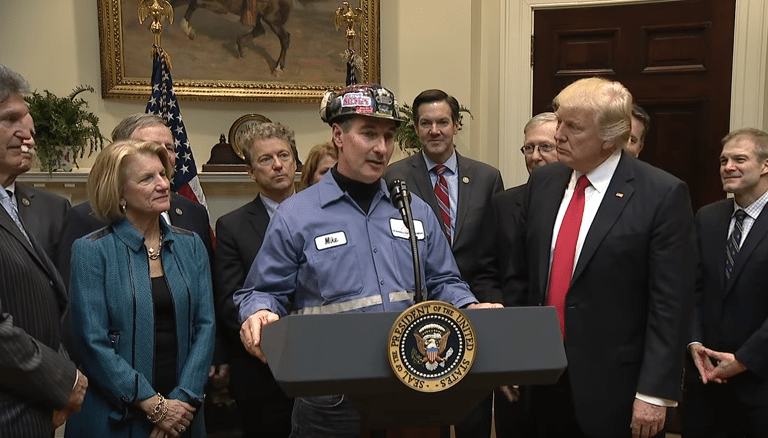 Press Conference Following the Disapproval of the Stream Protection Rule
Press Conference Following the Disapproval of the Stream Protection Rule
The United States Needs to Plan for a Post-Coal Economy
The announcement that the Trump Administration plans to end the Clean Power Plan is the latest action by the administration to dismantle the environmental initiatives that President Obama started before he left office. President Trump often cites his goal to protect the coal industry and coal miner’s jobs as the driver behind such repeals. In reality however, the coal industry continues to rapidly decline, primarily due to factors unrelated to President Obama’s initiatives. Since President Trump took office, 12 more coal-fired power plants have announced they are going to close. With these closures, half of America’s coal producing plants have been shuttered and only 261 remain.
While the coal industry employs just 52,000 people, down 70% over the last 30 years, the solar and wind industries employ 10 times that amount. Coal’s main competition isn’t renewable energy, however, but natural gas. In 2016, for the first time ever, natural gas represented a larger share of electricity generation than coal in the United States. According to a recent study, increased competition from natural gas accounts for 49% of coal’s decline, whereas the growth in renewable energy is just 18%. In addition, environmental regulation only contributes 3.5%, making Trump’s actions to repeal environmental regulation to “bring back coal” seem unlikely to prove successful.
There is no real way to save the coal industry. But as coal mines close, many people will lose their jobs and whole communities will lose their only source of income. Instead of repealing environmental regulation that will only harm the United States in the long run, the Trump Administration should do the opposite. Responding to the effects of climate change in a responsible, coherent manner is essential to ensuring the future prosperity and security of the United States. Regardless, coal miners are going to lose their jobs, and the Trump administration should be focusing on helping them find jobs in different sectors, instead of trying to prop up the failing industry.
Despite what can appear to be a bleak outlook, but there are options for former coal miners. There are programs across the country to train workers in renewable energy industries, teaching skills that range from how to install solar panels to how to maintain wind mills. Solar energy use in the U.S. rose 38% between 2015 and 2016 and solar jobs are growing 17 times faster than the U.S. economy. Wind energy jobs grew 20% between 2015 and 2016 and the industry now supports almost 90,000 jobs. But moving to renewable energy jobs is not possible for everyone, and can depend on geographical location and availability of retraining programs. Economists stress that diversification is essential, especially since renewable energy is not the perfect alternative – these industries cannot replicate the kind of long-lasting economic boom that coal did.
Recently, there has been the development of some unconventional programs aimed at getting coal miners back into the workforce – including teaching them how to code. Bit Source, a company in Kentucky, is training workers how to develop websites, tools, games, and apps. The program is small and could only accept 10 out of the 900 applicants, but could serve as an example for similar programs across the country. Another company, Appalachian Headwaters, is helping displaced coal workers get into the honey business. A larger effort is being spearheaded by the Appalachian Regional Commission. Their POWER initiative seeks to encourage economic diversification and has awarded over $94 million dollars to investment projects in 250 counties. These investments have created or helped retain almost 8,800 jobs.
There is no simple solution to this issue. For many, coal mining is not only a job, but a way of life that is deeply engrained in their culture. Coal mining is often a family legacy, and former coal miners can be hesitant to leave their hometowns to seek employment elsewhere. Local and state governments, along with the federal government, should be planning to help displaced workers with retaining programs and educational assistance to encourage job and economic recovery and growth. Getting coal miners back to work strengthens both the local and national economies, bolstering America’s national security. Efforts need to be put into planning for the future, not trying to revive the past. One thing is for certain – coal is not coming back.





